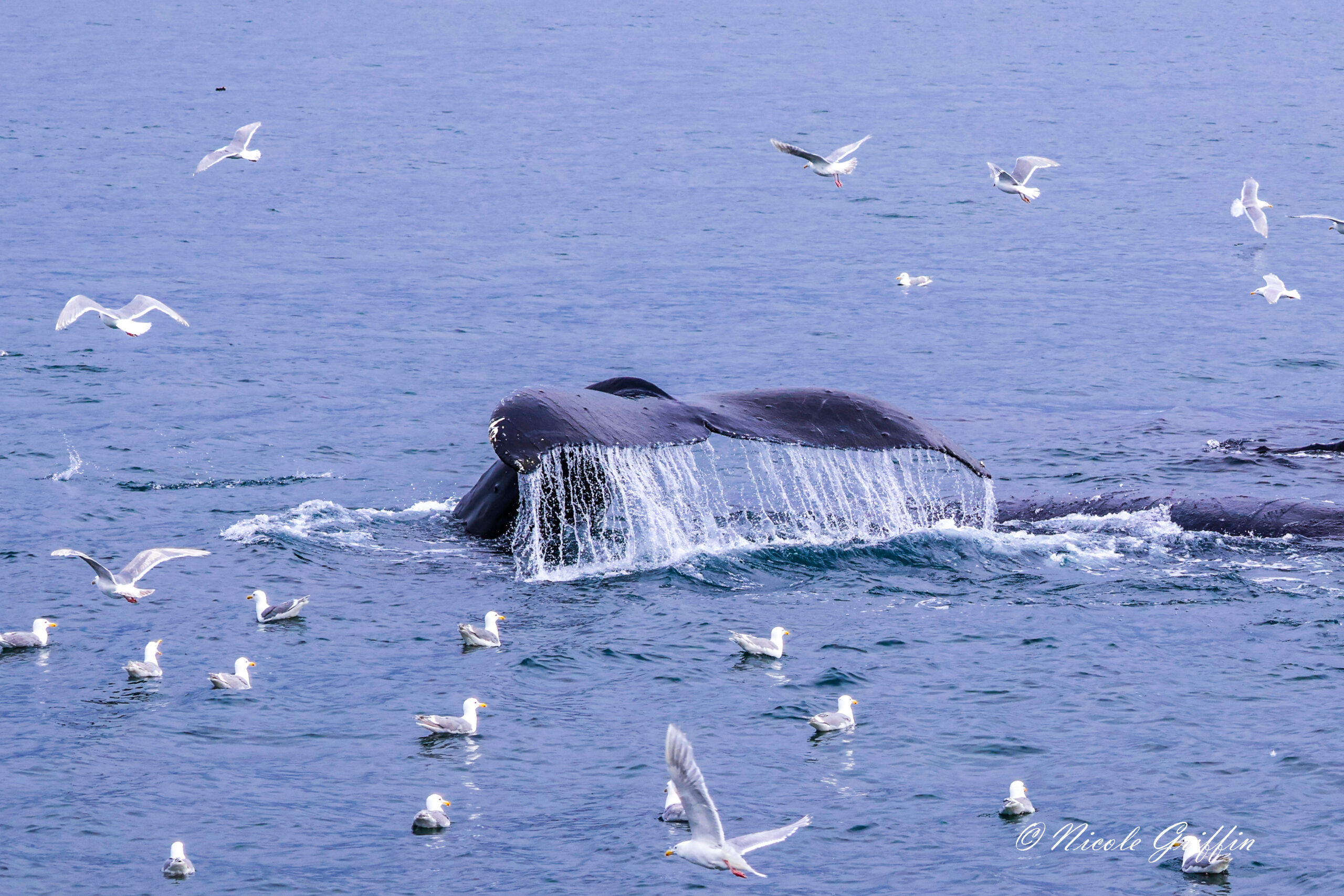Prior to my Alaskan cruise, the only whales I’d seen on whale-watching excursions had been orca, which I’d seen on two separate excursions in the Salish Sea, courtesy the highly recommended Puget Sound Express. In Alaska, I desperately wanted to see some other varieties of whales.
As I mentioned in my first Alaska post, I caught a glimpse of a humpback on the morning of my first day at sea, and I feared this first sighting would be my last. I needn’t have feared. Later that same day, my mom and I were passing through Cellar Masters wine bar. People seated by the windows began gasping and pointing, and we looked out the porthole to see a humpback whale breaching—again, and again, and again.
There are multiple theories on why whales breach. They may be communicating to other whales across long distances, showing off their physical prowess, or just playing. As best I can tell, the scientific consensus has swung behind the former theory, but I swear this particular whale seemed to be performing for us.
icy strait point
In Icy Strait Point, we took a dedicated whale watching excursion that we booked through the cruise line. (Whale watching was basically the only game in town at this port call, aside from eating crab and some shops.)
The guide on our double-deck boat told us that the waters around Hoonah are particularly attractive to humpbacks because it is situated at the confluence of multiple bodies of water, including the outlet of Glacier Bay, making the waters nutrient-rich and full of fish.
It was about a 30 min trip out to the feeding grounds. As we breezed through jade green waters bordered by evergreen-cloaked islands, we passed by a few orca and humpbacks languidly swimming along, sleek backs arching above the water in a curve before a final flick of their tail. I wished the captain would stop for photo opportunities, but he wisely blazed onward to where the real action was.

Once we got to the feeding grounds, the whales multiplied. We lingered for a long time among a herd of about 10 humpbacks, arching and flipping their tails at us.
We also got to witness a phenomenon known as bubble-net feeding, which is a coordinated hunting activity where the whales swim around in a circular motion deep underwater, blowing bubbles. As the bubbles create a “net” that the fish can’t escape from, the whales spiral up until they reach the surface. By now, their nets have created a dense concentration of fish, then suddenly—gulp.

The thing I find most intriguing about this behavior is that it’s not an instinctive behavior. It’s a learned behavior that’s culturally transmitted.
We’re so used to the anthropocentric worldview that describes animals as having “instinct” and humans as having “culture”. If I may adapt my own definition of culture as being “the social behaviors, norms, knowledge, customs, and habits of a group,” then whales totally have culture.
This concept has appeared in some podcasts and documentaries I’ve watched since then—not just about humpbacks, but other marine mammals too—and I’m now officially fascinated by the concept of animals having culture.
After the bubble-net feeding herd dispersed or dove, we lingered for a bit longer, watching a few loner whales, one of whom breached for us. (Sadly, my camera didn’t focus quickly enough, so I ended up with blurry photos of the breach, and a clear shot of the plume of water that erupted as he crashed back into the water.)


kenai fjords national park
Our second opportunity to witness the whales came after we had disembarked in Seward. We squeezed in one last boat excursion to Kenai Fjords National Park (courtesy Kenai Fjords Tours) where we saw more glaciers and lots of wildlife, including sea lions, harbor seals, puffins, murres, seagulls, one bald eagle… and lots more humpbacks and orcas.
If the whale-watching in Icy Strait Point was spectacular, in Kenai Fjords it was something even beyond that. It was a mostly sunny, placid day, and the waters were smooth. It was almost as if the whales relished the opportunity to soak up some sun rays, because they just kept appearing, and we witnessed bubble net after bubble net.
After a while we got a sense of the rhythm. When the whales begin making their bubble nets deep underwater, they make an intense sound. Unfortunately, those sound waves don’t seem to transmit above water in a way that is audible to the human ear (at least, I couldn’t hear anything). But the seagulls apparently can see or hear something, because in the minute or two before the whales emerged above the surface, the seagulls started going nuts, squawking and swooping, waiting to capitalize on the rush of fish that was about to emerge to the surface. Link to a video here.

Then the whales would appear, skins gleaming pewter grey in the sun, baleen throats stretching out as they engulfed their prey.
Oh yes, and more breaches, enough that I even caught them on camera this time, although still not that perfect shot at the apex of their arc through the air.

Even the captain remarked that he could have watched this all day, but we had other things to get on to.
Like a herd of sea lions, squabbling angrily on the rocks.

Like a pod of harbor seals, lounging on a bed of seaweed.

Like puffins bobbing on the waves.

Like orcas, gliding through the waters on their own hunting expeditions.

Like murres, the “penguins of the north”, huddling in a rocky crevasse.

But seriously, the whales. I couldn’t get enough.

